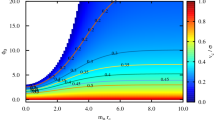Abstract
This paper deals with the question of whether elliptical galaxies can be considered as equilibrium systems (i.e., the gravitational+centrifugal potential is constant on the external surface). We find that equilibrium models such as Emden-Chandrasekhar polytropes and Roche polytropes withn=0 can account for the main part of observations relative to the ratio of maximum rotational velocity to central velocity dispersion in, elliptical systems. More complex models involving, for example, massive halos could lead to a more complete agreement. Models that are a good fit to the observed data are characterized by an inner component (where most of the mass is concentrated) and a low-density outer component. A comparison is performed between some theoretical density distributions and the density distribution observed by Younget al. (1978) in NGC 4473, but a number of limitations must be adopted. Alternative models, such as triaxial oblate non-equilibrium configurations with coaxial shells, involve a number of problems which are briefly discussed. We conclude that spheroidal oblate models describing elliptical glaxies cannot be ruled out until new analyses relative to more refined theoretical equilibrium models (involving, for example, massive halos) and more detailed observations are performed.
Similar content being viewed by others
References
Benacchio, L. and Galletta, G.: 1979, Preprint.
Binney, J.: 1976,Monthly Notices Roy. Astron. Soc. 177, 19.
Binney, J.: 1978,Monthly Notices Roy. Astron. Soc. 183, 501.
Binney, J. and Silk, J.: 1978, Comments,Astrophys. Space Sci. 5, 139.
Caimmi, R.: 1980,Astrophys. Space Sci. 71, 75.
Chandrasekhar, S.: 1933,Monthly Notices Roy. Astron. Soc. 93, 462.
Chandrasekhar, S.: 1939,An Introduction to the Study of the Stellar Structure, Chap. IV, The University of Chicago Press.
Chandrasekhar, S., and Lebovitz, N. R.: 1962,Astrophys. J. 136 1082.
Dallaporta, N. and Secco, L.: 1977,Astrophys. Space Sci. 50, 253.
Illingworth, G.: 1977,Astrophys. J. 218, L43.
James, R. A.: 1964,Astrophys. J. 140, 552.
Jeans, J.: 1929,Astronomy and Cosmogony, Chapts. VIII and IX, Dover Publications.
Linnell, A. P.: 1977,Astrophys. Space Sci. 48, 165.
Marchant, A. B. and Olson, D. W.: 1979,Astrophys. J. 230, L157.
Miller, R. H.: 1978,Astrophys. J. 223, 122.
Occhionero, F.: 1967,Mem. Soc. Astron. Ital. 38, (No. 2), 331.
Peterson, C. J.: 1978,Astrophys. J. 222, 84.
Schechter, P. L. and Gunn, J. E.: 1979,Astrophys. J. 229, 472.
Young, P., Sargent, W. L. W., Boksenberg, A., Lunds, C. R. and Hartwick, F. D. A.: 1978,Astrophys. J. 222, 450.
Author information
Authors and Affiliations
Rights and permissions
About this article
Cite this article
Caimmi, R. Can elliptical galaxies be equilibrium systems?. Astrophys Space Sci 71, 75–85 (1980). https://doi.org/10.1007/BF00646909
Received:
Revised:
Issue Date:
DOI: https://doi.org/10.1007/BF00646909




